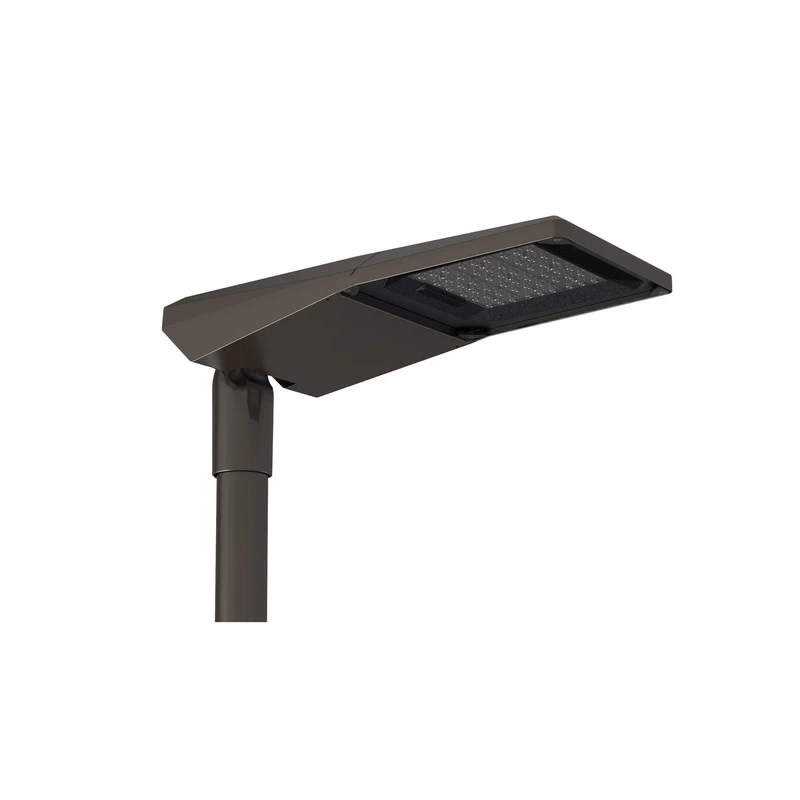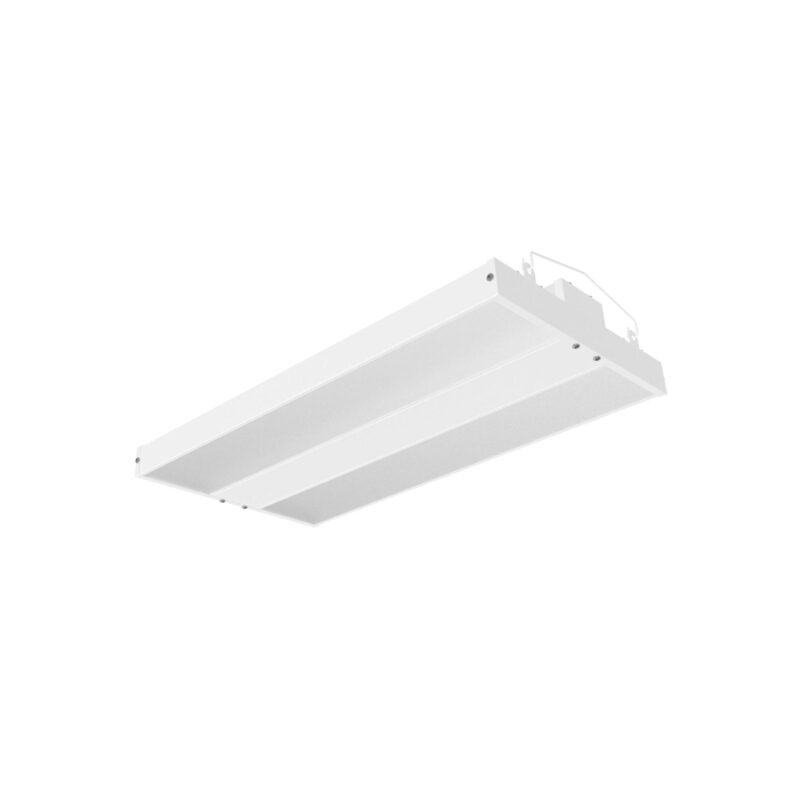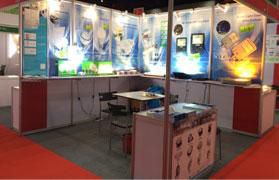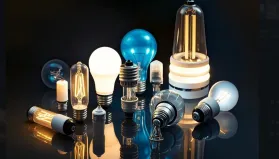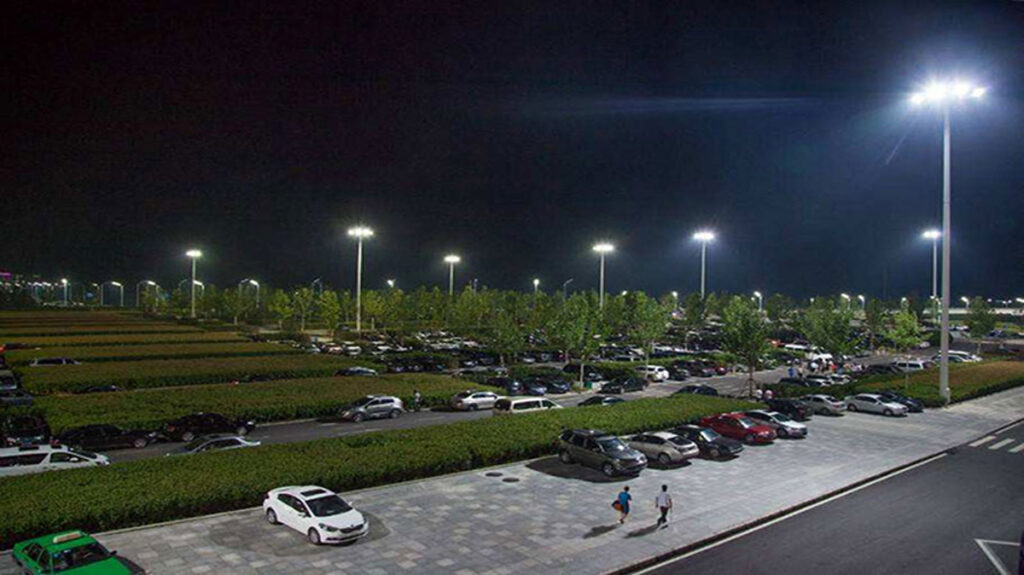目次
トグルはじめにLEDの光色とその重要性
照明の世界は、さまざまな種類のLEDライトに圧倒されることがあります。自宅、オフィス、工場、スポーツ会場など、どの場所を照らすにしても、適切な光の色を選ぶことが重要です。適切な雰囲気を作り出すのに役立ちます。
昼光色と明るい白色では、用途も設定も異なる。ソフトホワイトとウォームホワイトの電球は、部屋の雰囲気を変えることができます。このガイドは、これらの選択肢をナビゲートするのに役立ちます。
照明が環境に与える影響についての詳細はこちら、 可視光線についての記事をご覧ください。
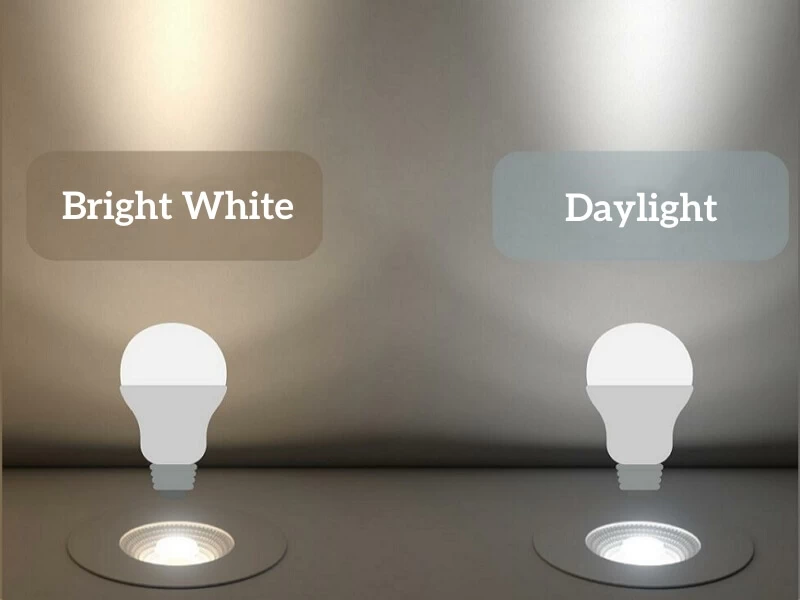
ワットとケルビンについて知っておくべきこと
さまざまなタイプのLEDライトに飛び込む前に、ワットとケルビンを理解することが不可欠だ:
ワットとは何か?
ワットとは、電球が消費するエネルギーのことである。ワットが大きいほどランプは明るく、消費電力は高くなります。従来の白熱電球は多くのワットを使用していました。
一方、最近のLED電球は消費電力が少ない。それでも高いルーメン出力が得られます。適切な電球を選ぶ際には、エネルギー効率を確保するためにワット数を考慮することが重要です。
ケルビンとは何か?
ケルビンは、LED照明から発せられる光の色温度を測定します。ケルビンが高いほど、昼光色電球のような青みがかった冷たい光になります。ケルビンが低いほど、ソフトホワイト電球のような暖かく柔らかい光になります。
電球の種類:内訳
さまざまなタイプのLEDライトに飛び込む前に、ワットとケルビンを理解することが不可欠だ。昼白色、明るい白色、柔らかい白色、冷たい白色、暖かい白色など。
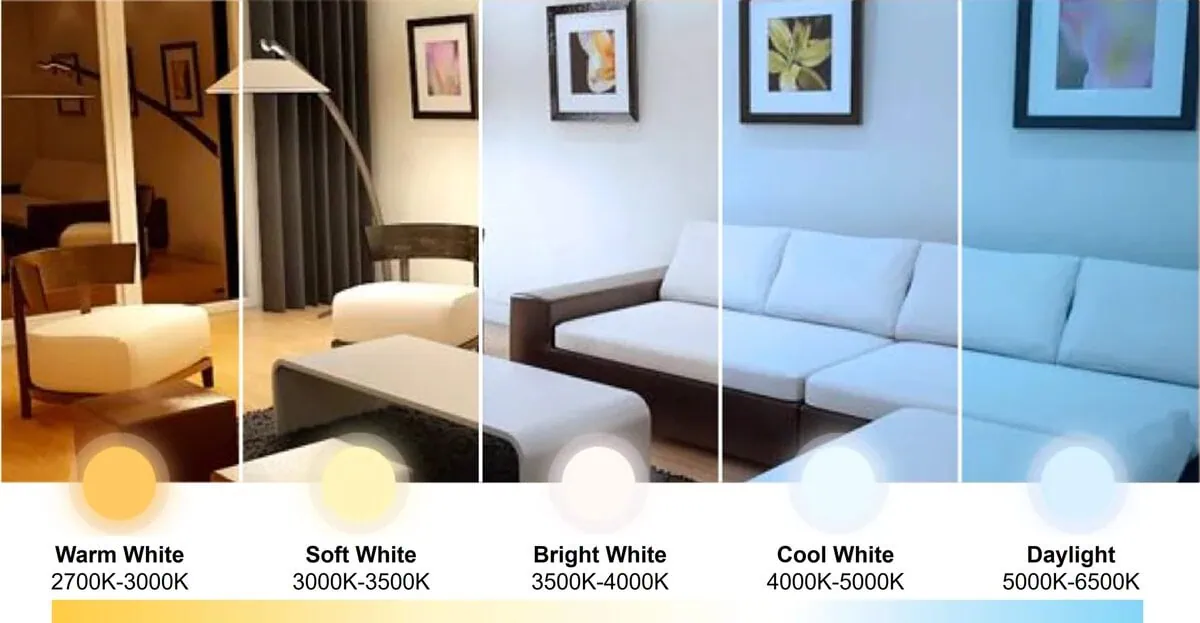
1.明るい白色電球と昼光色電球
ブライトホワイト電球と昼白色電球は、どちらも白く鮮明な外観からよく選ばれますが、その用途は異なります。ブライトホワイト電球は、キッチンやオフィスなど、鮮明さが求められる作業に最適です。昼白色電球は、自然の太陽光のように見えるように作られています。作業場やガレージなど、明るい光が必要な場所に最適です。
業務用では、ショールームや病院、大きなオフィスなどで昼光色電球がよく使われます。最適な昼光色電球の選び方について詳しく知りたい方は、こちらをご覧ください、 製品ページを見る.
コアの違い:色温度
- 昼光色:色温度は通常5000Kから6500K。この色温度は真昼の自然太陽光をシミュレートしている。
- 明るい白:色温度は通常3500Kから4100K。温白色と昼光色の中間。
視覚的な違い:
- デイライト:非常に正確な色再現を提供し、クリアで冷たく、わずかに青みがかった白。明瞭さ、注意深さ、集中力、現代性、清潔さ、技術といった雰囲気を醸し出す。光はシャープで、影のコントラストが比較的強い。
- 明るい白:ピュアでニュートラルな明るい白色で、優れた自然な色再現を実現。爽やかで明るく、効率的でバランスの取れたニュートラルな雰囲気を作り出します。温かみのある白色光よりも「活気」があり、昼光色よりも「親しみやすく」「自然」です。影は鮮明だが、まぶしくはない。
| 明るい色 | 視覚的特徴 | 代表的なアプリケーション |
|---|---|---|
| デイライト | 真昼の太陽光に似た、シャープでクリアなクールな白色光 | レジデンシャル: キッチンカウンター、ワークデスク、化粧スペース 産業用だ: ワークショップ、研究所、精密作業、倉庫 コマーシャルだ: 電光掲示板、クリニック、生鮮コーナー スポーツだ: ジムコート、ロッカールーム、視認性の高い場所 |
| ブライト・ホワイト | ニュートラルな白、クリーンでさわやか、自然な明るさ | レジデンシャル: 浴室、廊下、一般照明 産業用だ: オフィス、会議室、廊下 コマーシャルだ: 小売店、ショールーム、レストラン、診療所 スポーツだ: フィットネスゾーン、ウォーキングコース、ヘルスクラブ |
2.ソフト・ホワイトとウォーム・ホワイトの比較
ソフトホワイト電球は、温かみのあるイエロートーンの光を放ち、居心地のよい雰囲気を求めるリビングルームやベッドルームに最適です。ウォームホワイト電球は、居心地の良い暖かさを提供します。ダイニングやラウンジでリラックスした雰囲気を演出するのに最適です。
コアの違い:色温度
- ソフトホワイト:2700K - 3000K、従来の白熱灯/キャンドルライトの暖かさを再現。
- ウォームホワイト:3000K - 3500K、ハロゲンランプ/日の出と日没の暖かさをエミュレート。
視覚的な違い:
- ソフト・ホワイト:はっきりとしたオレンジ/アンバーの色合いで、より「黄色」の光を作り出します。より豊かでゆったりとした雰囲気で、休息とプライバシーを強く感じさせます。
- 温白色:ソフトホワイトよりやや白っぽく、黄みがかった柔らかな白色。暖かく、快適で、親しみやすく、自然で、ややエネルギッシュ。
| 明るい色 | 視覚的特徴 | 代表的なアプリケーション |
|---|---|---|
| ソフトホワイト | 温かみのある黄色の色調で、わずかに減少する可能性がある。レジデンシャル: メインベッドルームの照明、深夜のリビングルームのアンビエント照明、レストランのキャンドルディナー照明。 コマーシャルだ: 洋食レストラン、バー、カフェ、客室、廊下 | |
| ウォームホワイト | 物体の色はより自然で暖かく、ディテールはソフトホワイトよりわずかにシャープで、一般的に色再現性はわずかに優れている。 | レジデンシャル: リビングルーム主照明、ダイニングルーム主照明、ポーチ照明 コマーシャルだ: レストラン、コーヒーショップ、ベーカリー、ロビーラウンジ、パントリー |

3.クールホワイトとブライトホワイト
クール・ホワイトとブライト・ホワイトは、混同されやすい2種類のニュートラル~クールな白色光です。ここでは、その主な違い、視覚的な区別、選び方を説明します:
コアの違い:色温度
- クールホワイト:4000K~5000K、効率、落ち着き、現代性、テクノロジー、清潔感を表す。
- 明るい白:3500K - 4100K、明るさ、新鮮さ、効率、バランス、自然さを表す。
視覚的な違い:
- クールホワイト:クール・ホワイトは青みがかった色合いで、対象物にややクールな色合いを与える可能性がある。より理性的でシリアスな雰囲気を醸し出します。
- 明るい白:暖色も寒色もはっきりしない純粋でニュートラルな白で、対象物を最も自然なバランスで見せることができる。
重要な考慮事項
- 落ち着いた、効率的な、技術的に進んだ、超高精細をお探しですか?クールホワイト(4000K-5000K)をお選びください。
例えば、手術室、研究所、電子機器工場などだ。 - 明るく、プロフェッショナルで、ニュートラルで、ナチュラルな外観をお探しですか?ブライトホワイト(3500K-4100K)をお選びください。
例えば、オフィス、教室、小売店、一般的な商業地域など。 - 簡単なヒント:
クールホワイト=クールさ、テクノロジー、真面目さ
ブライト・ホワイト=中立性、汎用性、自然さ

4.昼光色とソフトホワイトの違い
昼光色とソフトホワイトは色温度の両極端であり、その視覚体験や適用シーンは大きく異なる。
- ソフトホワイト:色温度2700K~3000Kで、暖かみのある黄色。少しぼんやりした感じで、暖かく、リラックスした、ゆったりとした雰囲気を作り出します。休憩やリラクゼーションエリアに適しています。
- 昼光色:5000K~6500Kの色温度で、真昼に近いクールな白色。爽やかで爽快感があり、少しひんやりとした感覚さえ与えます。集中力の高い作業場に適しています。
| タイプ | 色温度 (K) | 軽い外観 | 典型的な使用例 |
|---|---|---|---|
| デイライト | 5000K - 6500K | 青みがかったクールでさわやかな白 | オフィス、ワークショップ、読書、タスク照明 |
| ソフトホワイト | 2700K - 3000K | 黄色がかった暖かく居心地の良い光 | リビングルーム、ベッドルーム、アンビエント照明 |
最適な電球選びのポイント
あなたのニーズに最適な電球を選択する際に考慮すべきいくつかの要因があります:
- 明るい白と昼光色のどちらが明るいか?
ブライトホワイト電球とデイライト電球の主な違いは明るさです。昼光色電球は一般的にケルビン値が高く、明るい光を放ち、細かい作業に最適です。 - ソフトホワイトとウォームホワイトの違い
どちらのタイプの電球も温かい雰囲気を醸し出します。ソフトホワイトの電球は柔らかく、くつろいだ雰囲気に最適です。ウォームホワイト電球は明るい光で、広い商業スペースに最適です。
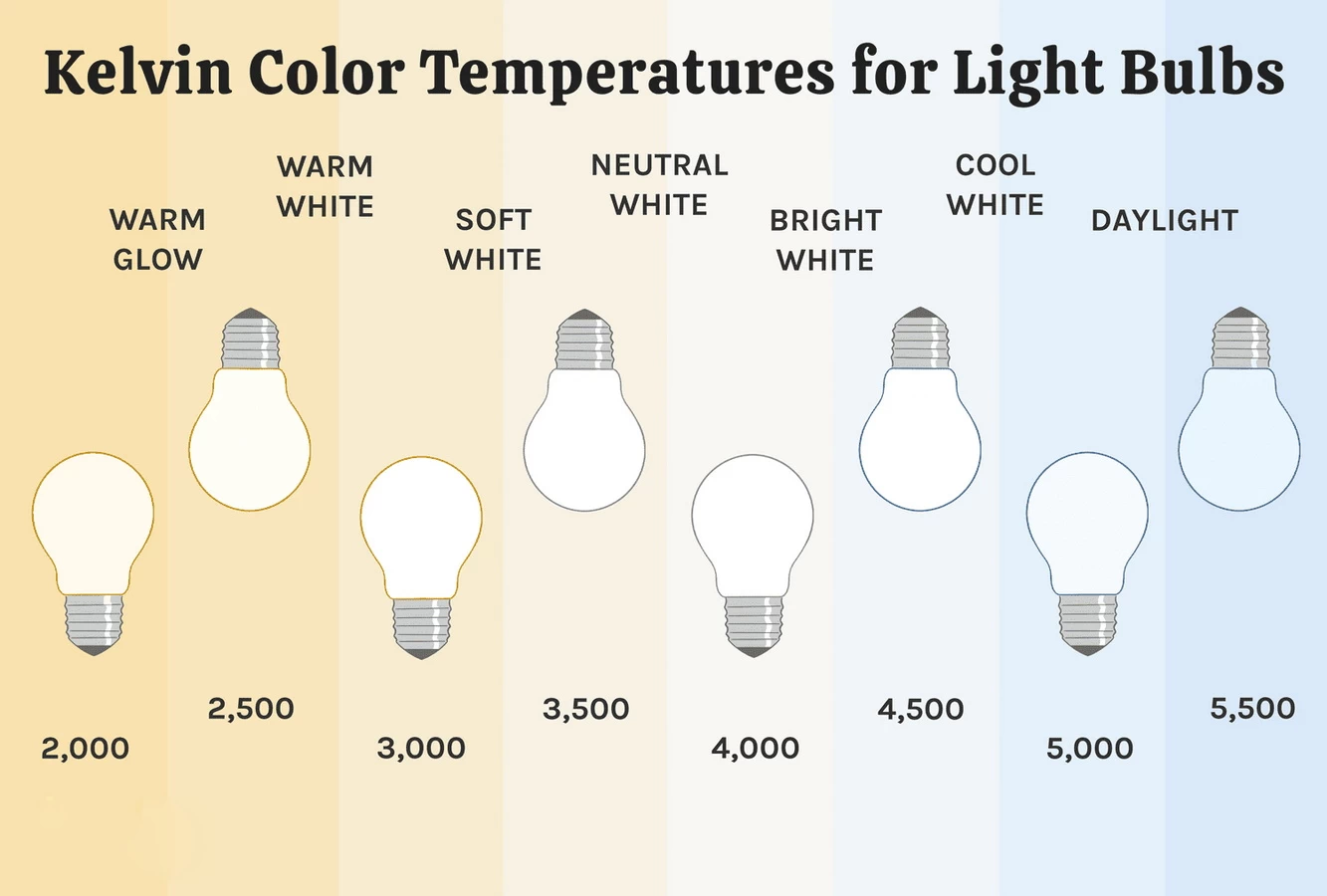
産業、スポーツ、商業用途
照明はさまざまな分野で重要な役割を果たしている:
- 産業用途
産業環境では、照明は明るく信頼できる必要があります。倉庫、工場、生産ラインでは昼光色電球が好まれます。ブライトホワイト電球は、精密さと集中力を必要とする場所でよく使用されます。 - スポーツ・アプリケーション
スポーツ会場では、照明が眼精疲労を引き起こすことなく明瞭な視界を確保しなければなりません。明るい白色と昼光色のLEDは、発光効率が高いため、スタジアム、アリーナ、コートで一般的に使用されています。 - 商業用途
オフィスや店舗、ショールームなどの商業空間では、照明が第一印象を決めます。昼光色は明瞭な印象を与え、ソフトホワイトやウォームホワイトの電球は居心地のよい雰囲気を演出します。
商業空間の照明の選び方について、詳しくはこちらをご覧ください、 製品ページをご覧ください。
結論照明のニーズに合った正しい選択
正しい照明を選ぶには、電球のケルビンとワットを理解し、用途を考慮する必要があります。適切な電球を選ぶことは、スペースにとって重要です。
エネルギーの高い環境には、昼光色か明るい白色を。居心地の良い環境には、ソフトホワイトかウォームホワイトが最適です。適切な電球は、快適性と機能性を大きく向上させます。
照明を変えたいとお考えの方は、お気軽に下記までご連絡ください。 お問い合わせ私達の専門家チームはあなたのための照明解決をカスタマイズします
人々はこうも尋ねる
LED照明のソフトホワイトとは何色ですか?
LED照明のソフトな白色光は、従来の白熱灯やろうそくの光、夕焼けの温かみのある光に似た、独特の琥珀色や黄色味を帯びた典型的な低色の温かみのある黄色い光である。暖かく、ゆったりとしたリラックス感をもたらします。
クールホワイトとブライトホワイトはよく似ているようですが、どちらかを選べばいいのでしょうか?
クール・ホワイトとブライト・ホワイトは視覚的にはよく似ていますが、微妙に異なる雰囲気を醸し出します。クール・ホワイトは青みがかった色合いが多く、タスク照明やワークスペースに最適です。明るい白は、やや暖色または寒色を帯びる傾向があります。特定のムードや効果を求めていない場合は、どちらを選んでも構いません。
LED照明で最もよく使われているのは明るい白色ですか?どのような場面でよく使われているのでしょうか?
そう、ブライトホワイトは、最も一般的に使用されているLEDの色温度のひとつです。その明るくニュートラルで自然な特質から、多くの家庭、商業施設、工業スペースで人気のある選択肢となっています。
例えば、キッチン、バスルーム、勉強部屋、道路、小売店、倉庫、工場の廊下など。
LED照明における真白と昼光色の違いは何ですか?
トゥルーホワイト:4000K - 4500Kの色温度、純粋なニュートラルホワイト、明るく、プロフェッショナルで、まぶしさのない自然な白色。真の色と快適な照明を必要とするシーンに最適。
昼光色:色温度5000K - 6500K、青みがかったクールホワイト。高い精度と焦点を必要とするプロフェッショナルな分野に最適。



